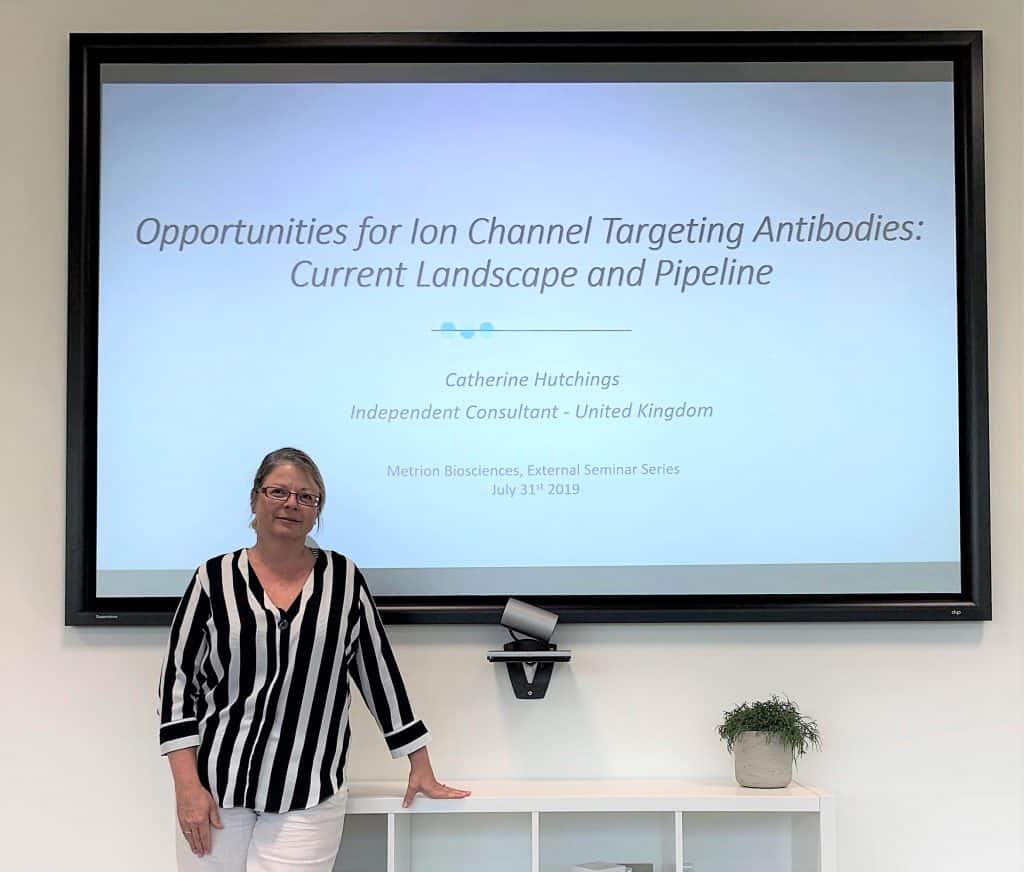External Speaker Series presentation featuring Dr Catherine Hutchings
Metrion Biosciences’ tenth External Speaker Series presentation featured Dr Catherine Hutchings, a highly experienced biologics drug discovery researcher and independent consultant. Dr Hutchings’ presentation included an overview of membrane proteins as drug targets and the evolution of antibody therapeutics technology, spanning isolation of the first mouse monoclonal antibody (mAb) hybridoma to exploitation of the favourable properties of antibodies for therapeutic purposes.

The current landscape of biologics
Dr Hutchings initially reviewed the biologics landscape for membrane bound proteins, focusing on G-protein-coupled receptors (GPCRs) and ion channels (covering 4% and 1.5% of the human genome, respectively). Biologics-based therapies for GPCR proteins are expected to begin a phase of rapid growth, with two GPCR directed antibodies currently approved for therapeutic use and techniques to overcome the technical issue of insolubility in aqueous solution and stabilisation of structure becoming more widely available.
For ion channels, global therapeutic approved drug sales exceed £12 Bn per annum, targeting just 8% of the available family of ion channel proteins. Approved therapies are all either small molecules or peptides, reflecting both the historical challenges for ion channel drug discovery and untapped potential for biologics approaches. Complex conformational and functional dynamics and, crucially, relative lack of structural information compared to other important drug target classes such as kinases and GPCRs, means that ion channels are still a difficult class of proteins for researchers.
The struggle with biologics
Furthermore, Dr Hutchings outlined multiple additional barriers to overcome for biologics research; spanning the difficulties associated with expression and purification of ion channels, to obtaining suitable amounts for immunisation and technically demanding follow on screening assays.
The generally short and conserved ion channel extracellular domains (ECDs) also limits availability of potential epitopes. Despite these technical complications opportunities do exist, with significant biologics R&D interest focused on channels such as the ASIC and P2X families, where a large ECD and a proportionally enhanced epitope were seen as an opportunity for researchers. The latter being targeted by Biosceptre (Cambridge, UK), currently progressing a Phase II study for treatment of basal cell carcinoma using their polyclonal antibody BIL010t recognising a non-functional form of P2X7.
Advantages of antibody-based therapeutics
Dr Hutchings also shared the wealth of potential advantages for antibody-based therapeutics over small molecules. This included an improved selectivity profile, limited CNS penetration (advantageous for peripheral targets), lower variability in patient pharmacokinetics and improved half-life.
Recent advances in ion channel structure elucidation via CryoEM, combined with novel platforms for immunisation, recombinent protein expression and post immunisation antibody characterisation should enhance the progression of novel antibody therapeutics targeting membrane proteins. DNA immunization has recently rivalled the more traditional use of peptide immunogens and native protein folding can be maintained by synthetic model membrane system (such as nanodiscs) and SMA lipid particles (SMALPs) for antibody characterisation.
New techniques for enhancing recombinant protein production levels are also emerging, for example TetraGenetics protisit-based system yields high levels of correctly folder recombinant human ion channels. Dr Hutchings also stressed that traditional drug discovery functional assays may need to be adapted when working with antibodies for ion channel targets, sometimes necessitating high quality, long duration electrophysiology recordings to accurately reflect the slower binding kinetics of biologics.
Biologics targeting ion channels
Biologics-based ion channel modulation was also discussed, with a particular focus on the sodium channel Nav1.7 – a target still of great interest to analgesics researchers, despite the multiple Phase II failures for small molecule inhibitors. Nav1.7 blocking peptides, such as GpTx-1 and JzTx-V isolated from tarantula venom, are proving to be useful tools for both experimental research and for antibody conjugation.
Amgen reported JzTx-V as being able to block histamine-induced pruritis in mice following subcutaneous administration and more recently it has been used as the basis of an antibody-peptide conjugate. It will be interesting to see if the early research publicised by Shionogi (mAb) or Amgen (antibody-peptide conjugate) can be more successful than the Nav1.7 blocking small molecules evaluated to date.
It is also hoped that new, functional biologics targeting ion channels will be discovered in the not too distant future; with increasing availability of structural information for ion channel proteins, coupled to recent advances in purification and assay technology and emerging new computational techniques all contributing towards an enhanced chance of success for this target class.
Looking to the future
At the conclusion of the presentation Dr Hutchings suggested that the ligand-gated P2X family and also voltage-gated Kv1.3 family of ion channels are likely future success stories for mAb targeted therapy, with two-pore domain (K2P) and transient receptor potential cation channels (most notably TRPV1) also showing potential.
References
- Hutchings, C.J.; Colussi, P. & Clark, T.G. (2019) Ion channels as therapeutic antibody targets. mAbs, 11:2, 265-296, DOI: 10.1080/19420862.2018.1548232.
- Haustrate, A.; Hantute-Ghesquier, A.; Prevarskaya, N. and Lehen’kyi, V. (2019) Monoclonal Antibodies Targeting Ion Channels and Their Therapeutic Potential. Front. Pharmacol. 10:606. doi: 10.3389/fphar.2019.00606
